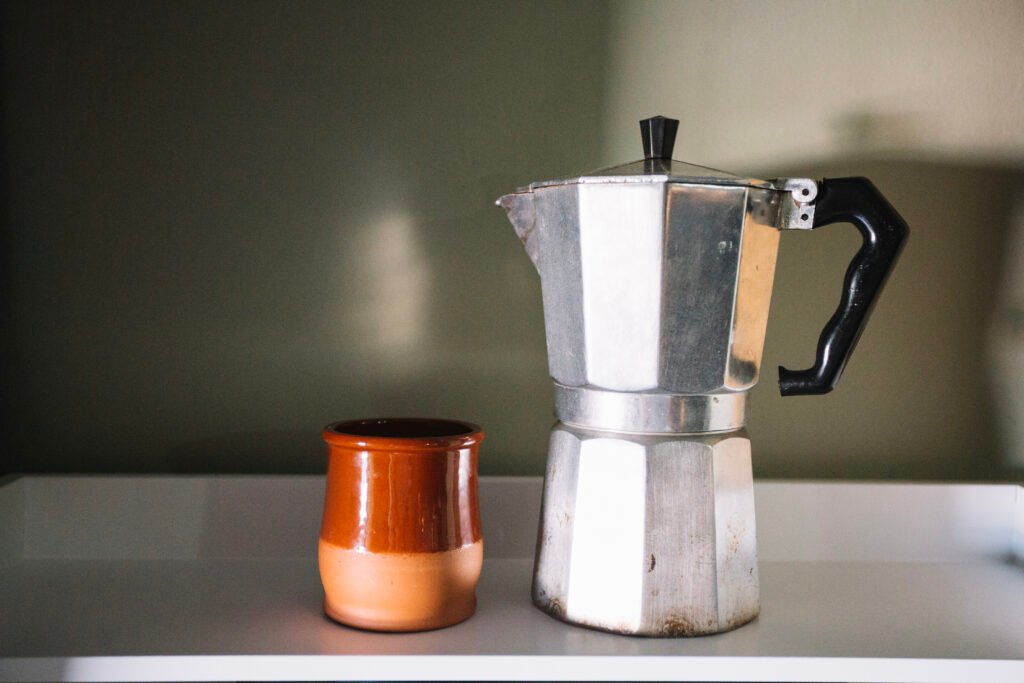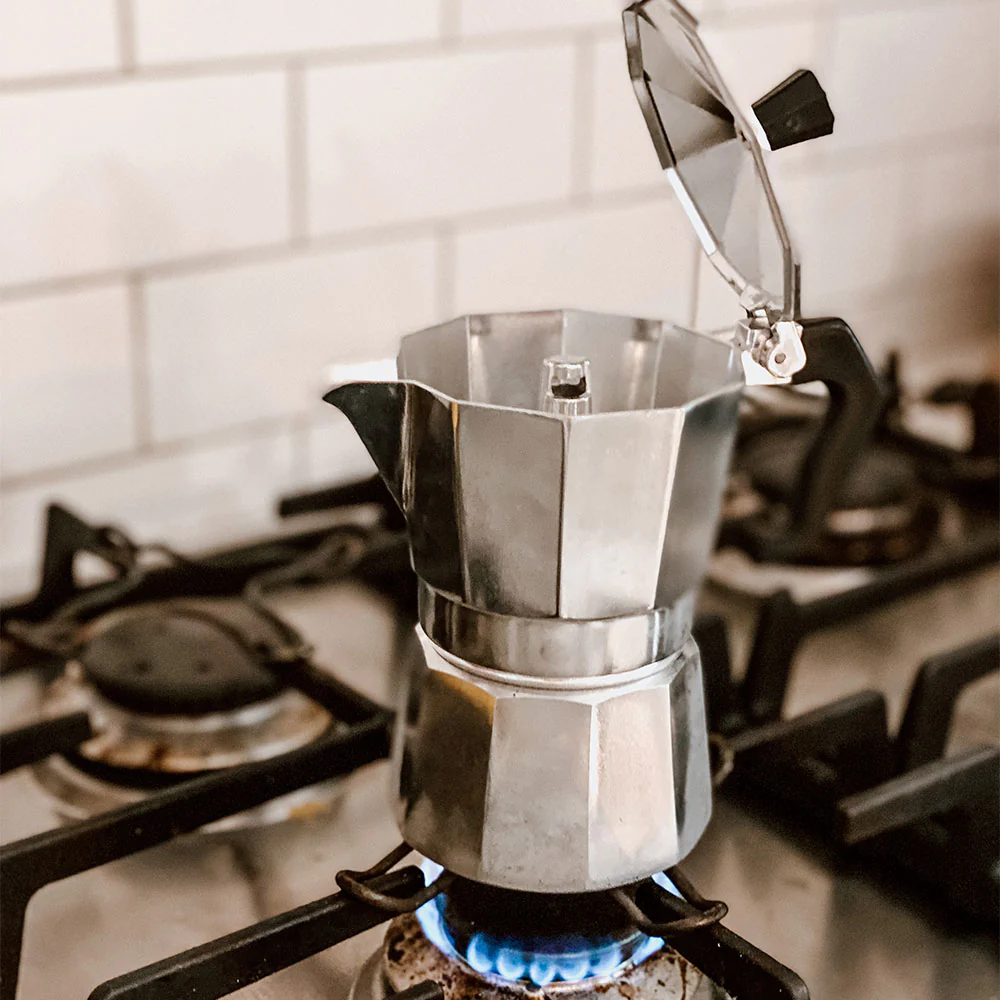Table of Contents
ToggleIntroduction
Do you want to learn how to make espresso at home? Espresso lovers sometimes crave a shot of espresso but have to wait on their local coffee shop to get one. If you’re interested in preparing espresso at home but cannot afford an espresso machine, this post will show you an alternative way to go about your homemade espresso.
You can make espresso at home using a timeless and affordable tool – the Moka Pot, often referred to as the “stove espresso maker.” While the Moka Pot doesn’t produce true espresso, it creates a strong, flavorful coffee that many find just as satisfying.
In preparing to write this post, I did some experiments with my Moka Pot especially some of the tips I learned from this video.

Understanding the Moka Pot
Brief History
The moka pot, a staple in Italian households since its invention in 1933, revolutionized home coffee brewing. It invented by Luigi di Ponti. The machine was quickly put into production by a mustachioed metal machinist from Piedmont, Alfonso Bialetti, who transformed di Ponti’s so-called “Moka Express”, an aluminum, pressure-driven stove-top coffee brewer, into one of the most famous, familiar brewers in the world.
The Moka Pot made it possible to enjoy espresso-like coffee at home without the need for a bulky, expensive machine. Its design has remained largely unchanged since its inception, a testament to its effectiveness and timeless appeal. For coffee enthusiasts who wish to make espresso at home, understanding the history and functionality of the moka pot is the first step.
Structure and Function
A moka pot consists of three main parts: the bottom chamber, the filter basket, and the top chamber. The bottom chamber holds the water, the filter basket contains the ground coffee, and the top chamber collects the brewed coffee. When heated, the water in the bottom chamber turns to steam, creating pressure that forces the water up through the coffee grounds and into the top chamber. This process results in a strong and flavorful brew, often referred to as “moka pot espresso.”
How to Make Espresso at Home with a Moka Pot in 5 Steps

To make espresso at home with a moka pot, follow these five simple steps:
Step 1: Grind Your Coffee Beans
Start by grinding fresh coffee beans to a fine consistency, slightly coarser than what you would use for an espresso machine. The grind size is crucial for optimal extraction and for achieving that espresso-like flavour. Using fresh, high-quality beans will significantly enhance the taste of your home-brewed espresso. Aim for a grind that resembles fine sand but not so fine that it clogs the filter.
Step 2: Prepare the Moka Pot
Fill the bottom chamber of the moka pot with hot water up to the safety valve level. Using hot water reduces the time the coffee grounds are exposed to heat, preventing a burnt taste and enhancing the flavour of your home-brewed espresso. This step is essential because starting with hot water minimizes the risk of over-extraction, which can lead to bitterness in your coffee. Be mindful of how you handle the hot water and the Moka Pot when it is hot, to avoid burns.
Step 3: Fill the Filter Basket
Fill the filter basket with ground coffee, levelling it off without pressing down too hard. A gentle tap will settle the grounds evenly, ensuring a consistent extraction process. It’s important not to pack the coffee too tightly, as this can impede the flow of water and result in uneven extraction. Level the coffee grounds with a flat edge for an even surface, which helps maintain uniform brewing. I saw a video where somebody used a little stick to stir the ground so it was not packed too tightly.
Step 4: Assemble and Heat
Assemble the moka pot by placing the filter basket in the bottom chamber and screwing the top chamber on tightly. Ensure all parts are securely fastened to avoid leaks. Place the moka pot on the stove over medium heat, leaving the lid open so you can observe the brewing process. As the water heats, it will create steam pressure that forces the water through the coffee grounds and into the upper chamber. Close the pot at this point and listen for a hissing sound. As soon as you hear the sound, remove the Moka Pot from the heat.
Step 5: Serve and Enjoy
Pour your strong, moka pot coffee into a cup and enjoy it straight or use it as a base for other coffee drinks. This “espresso” you make at home with a moka pot will be rich and flavorful, a perfect way to start your day. The coffee can also be customized to suit your taste by adjusting the grind size or using different coffee blends. Experiment with your brewing process to find your perfect cup.

Enhancing Your Moka Pot Coffee
Tips for Better Flavor
For the best flavour when you make espresso at home with a moka pot, consider these additional tips:
- Use Fresh Beans: Fresh, high-quality coffee beans provide a superior flavour compared to pre-ground coffee.
- Grind Just Before Brewing: Grind your coffee just before brewing to maintain its rich aroma and taste.
- Regular Cleaning: Clean your moka pot regularly. After each use, disassemble and rinse all parts with warm water. Avoid using soap, as it can leave residual flavours.
- Consistent Heat: Use medium heat to control the brewing process and avoid overheating, which can cause bitterness. Adjusting the heat can help you fine-tune the extraction rate.
Conclusion
With these five simple steps, you are equipped to make espresso at home with a moka pot. This method provides a strong, delicious coffee that serves as a fantastic alternative to traditional espresso. By experimenting with different coffee blends and techniques, you can enjoy a rich, satisfying brew any time you like.
Ready to try?
Share your moka pot coffee experiences and tips in the comments below! Don’t forget to subscribe to my Zuma Coffee blog for more tips on making coffee at home. You can make every cup a journey and a memorable experiment.
Happy brewing!

esewalter
Mom | Yoga Teacher | Coffee Blogger | Legal Mind. I explore coffee's journey from farm to cup and especially how you can start your home brewing journey.




